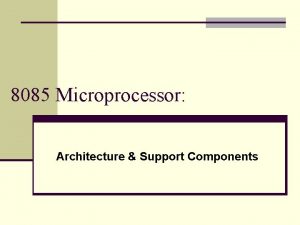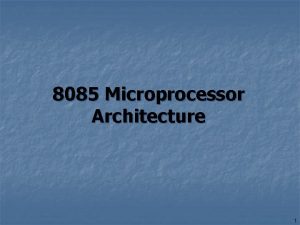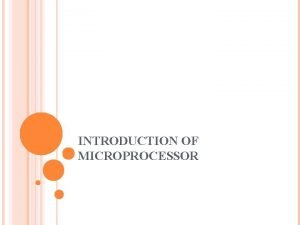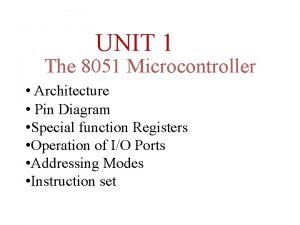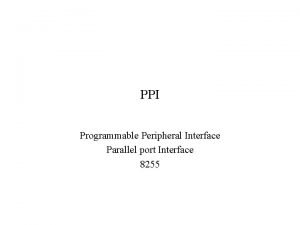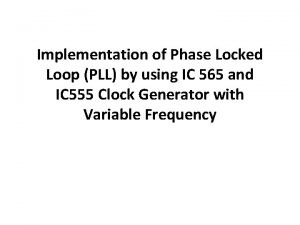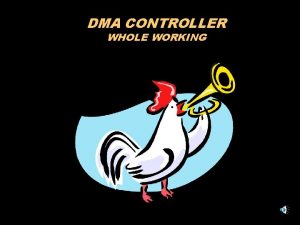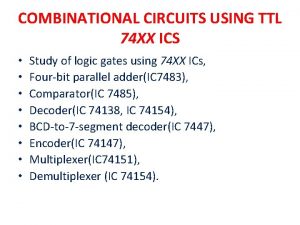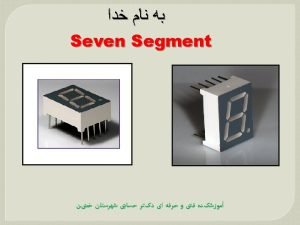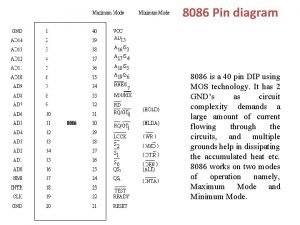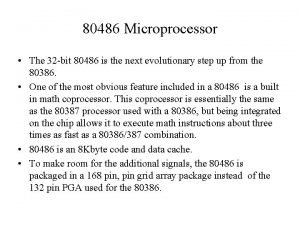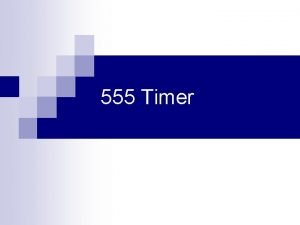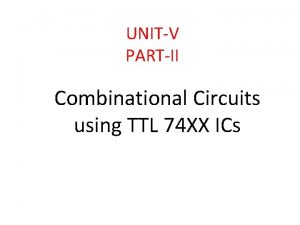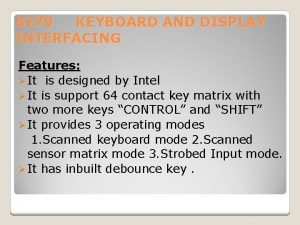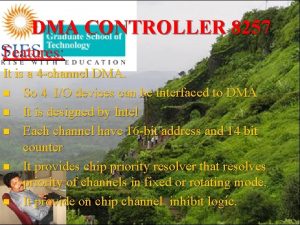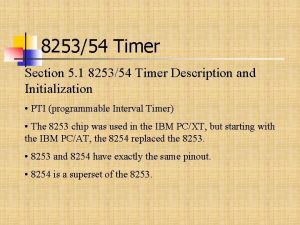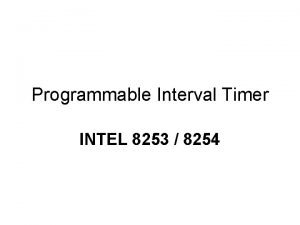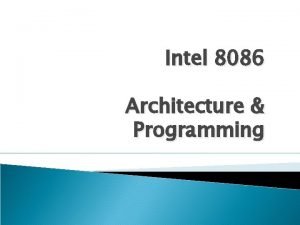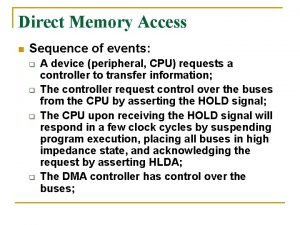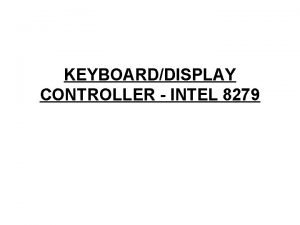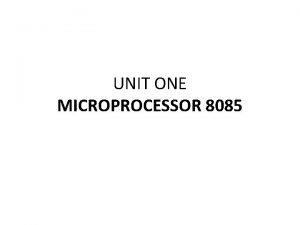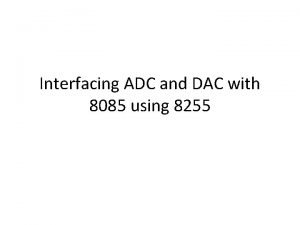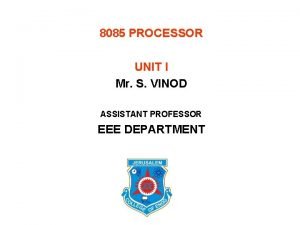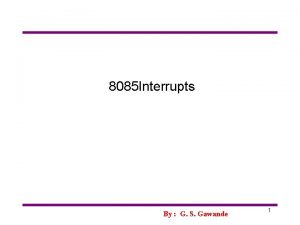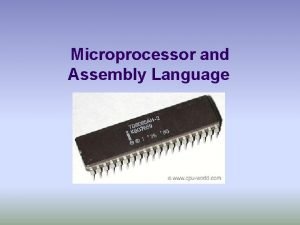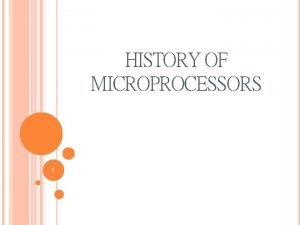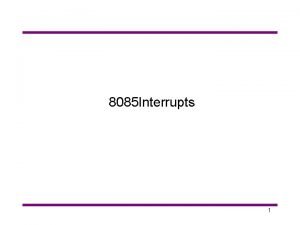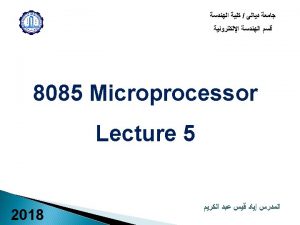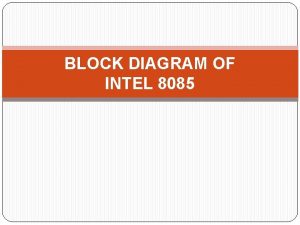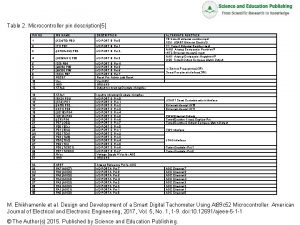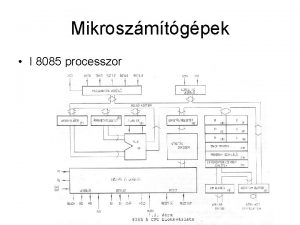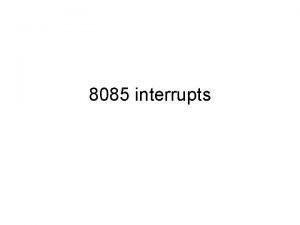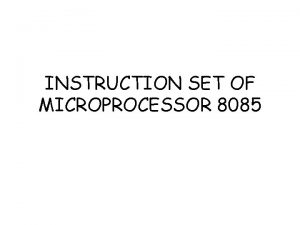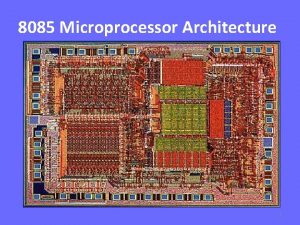PIN DIAGRAM OF 8085 Introduction to 8085 It
















































- Slides: 48

PIN DIAGRAM OF 8085

Introduction to 8085 It was introduced in 1977. It is 8 -bit microprocessor. Its actual name is 8085 A. It is single NMOS device. It contains 6200 transistors approx. Its dimensions are 164 mm x 222 mm. It is having 40 pins Dual. Inline-Package (DIP). www. eazynotes. com

Introduction to 8085 It has three advanced versions: ◦ 8085 AH 2 ◦ 8085 AH 1 These advanced versions are designed using HMOS technology. www. eazynotes. com

Introduction to 8085 The advanced versions consume 20% less power supply. The clock frequencies of 8085 are: ◦ ◦ 8085 AH 2 8085 AH 1 www. eazynotes. com 3 MHz 5 MHz 6 MHz

Pin Diagram of 8085 www. eazynotes. com

X 1 & X 2 Pin 1 and Pin 2 (Input) These are also called Crystal Input Pins. 8085 can generate clock signals internally. To generate clock signals internally, 8085 requires external inputs from X 1 and X 2. www. eazynotes. com

RESET IN and RESET OUT Pin 36 (Input) and Pin 3 (Output) RESET IN: ◦ It is used to reset the microprocessor. ◦ It is active low signal. ◦ When the signal on this pin is low for at least 3 clocking cycles, it forces the microprocessor to reset itself. www. eazynotes. com

RESET IN and RESET OUT Pin 36 (Input) and Pin 3 (Output) Resetting the microprocessor means: ◦ Clearing the PC and IR. ◦ Disabling all interrupts (except TRAP). ◦ Disabling the SOD pin. ◦ All the buses (data, address, control) are tri -stated. ◦ Gives HIGH output to RESET OUT pin. www. eazynotes. com

RESET IN and RESET OUT Pin 36 (Input) and Pin 3 (Output) RESET OUT: ◦ It is used to reset the peripheral devices and other ICs on the circuit. ◦ It is an output signal. ◦ It is an active high signal. ◦ The output on this pin goes high whenever RESET IN is given low signal. ◦ The output remains high as long as RESET IN is kept low. www. eazynotes. com

SID and SOD Pin 4 (Input) and Pin 5 (Output) SID (Serial Input Data): o It takes 1 bit input from serial port of 8085. o Stores the bit at the 8 th position (MSB) of the Accumulator. o RIM (Read Interrupt Mask) instruction is used to transfer the bit. www. eazynotes. com

SID and SOD Pin 4 (Input) and Pin 5 (Output) SOD (Serial Output Data): o It takes 1 bit from Accumulator to serial port of 8085. o Takes the bit from the 8 th position (MSB) of the Accumulator. o SIM (Set Interrupt Mask) instruction is used to transfer the bit. www. eazynotes. com

Interrupt Pins Interrupt: • It means interrupting the normal execution of the microprocessor. • When microprocessor receives interrupt signal, it discontinues whatever it was executing. • It starts executing new program indicated by the interrupt signal. • Interrupt signals are generated by external peripheral devices. • After execution of the new program, microprocessor goes back to the previous program. www. eazynotes. com

Sequence of Steps Whenever There is an Interrupt Microprocessor completes execution of current instruction of the program. PC contents are stored in stack. PC is loaded with address of the new program. After executing the new program, the microprocessor returns back to the previous program. It goes to the previous program by reading the top value of stack. www. eazynotes. com

Five Hardware Interrupts in 8085 TRAP RST 7. 5 RST 6. 5 RST 5. 5 INTR www. eazynotes. com

Classification of Interrupts Maskable Vectored Edge and Non-Maskable and Non-Vectored Triggered and Level Triggered Priority Based Interrupts www. eazynotes. com

Maskable Interrupts Maskable interrupts are those interrupts which can be enabled or disabled. Enabling and Disabling is done by software instructions. www. eazynotes. com

Maskable Interrupts List of Maskable Interrupts: • RST 7. 5 • RST 6. 5 • RST 5. 5 • INTR www. eazynotes. com

Non-Maskable Interrupts The interrupts which are always in enabled mode are called nonmaskable interrupts. These interrupts can never be disabled by any software instruction. TRAP is a non-maskable interrupt. www. eazynotes. com

Vectored Interrupts The interrupts which have fixed memory location for transfer of control from normal execution. Each vectored interrupt points to the particular location in memory. www. eazynotes. com

Vectored Interrupts List of vectored interrupts: • RST 7. 5 • RST 6. 5 • RST 5. 5 • TRAP www. eazynotes. com

Vectored Interrupts The addresses to which program control goes: Name Vectored Address RST 7. 5 003 C H (7. 5 x 0008 H) RST 6. 5 0034 H (6. 5 x 0008 H) RST 5. 5 002 C H (5. 5 x 0008 H) TRAP 0024 H (4. 5 x 0008 H) Absolute address is calculated by multiplying the RST value with 0008 H. www. eazynotes. com

Non-Vectored Interrupts The interrupts which don't have fixed memory location for transfer of control from normal execution. The address of the memory location is sent along with the interrupt. INTR is a non-vectored interrupt. www. eazynotes. com

Edge Triggered Interrupts The interrupts which are triggered at leading or trailing edge are called edge triggered interrupts. RST 7. 5 is an edge triggered interrupt. It is triggered during the leading (positive) edge. www. eazynotes. com

Level Triggered Interrupts The interrupts which are triggered at high or low level are called level triggered interrupts. RST 6. 5 RST 5. 5 INTR TRAP is edge and level triggered interrupt. www. eazynotes. com

Priority Based Interrupts Whenever there exists a simultaneous request at two or more pins then the pin with higher priority is selected by the microprocessor. Priority is considered only when there are simultaneous requests. www. eazynotes. com

Priority Based Interrupts Priority of interrupts: Interrupt Priority TRAP 1 RST 7. 5 2 RST 6. 5 3 RST 5. 5 4 INTR 5 www. eazynotes. com

TRAP Pin 6 (Input) It is a non-maskable interrupt. It has the highest priority. It cannot be disabled. It is both edge and level triggered. It means TRAP signal must go from low to high. And must remain high for a certain period of time. TRAP is usually used for power failure and emergency shutoff. www. eazynotes. com

RST 7. 5 Pin 7 (Input) It is a maskable interrupt. It has the second highest priority. It is positive edge triggered only. The internal flip-flop is triggered by the rising edge. The flip-flop remains high until it is cleared by RESET IN. www. eazynotes. com

RST 6. 5 Pin 8 (Input) It is a maskable interrupt. It has the third highest priority. It is level triggered only. The pin has to be held high for a specific period of time. RST 6. 5 can be enabled by EI instruction. It can be disabled by DI instruction. www. eazynotes. com

RST 5. 5 Pin 9 (Input) It is a maskable interrupt. It has the fourth highest priority. It is also level triggered. The pin has to be held high for a specific period of time. This interrupt is very similar to RST 6. 5. www. eazynotes. com

INTR Pin 10 (Input) It is a maskable interrupt. It has the lowest priority. It is also level triggered. It is a general purpose interrupt. By general purpose we mean that it can be used to vector microprocessor to any specific subroutine having any address. www. eazynotes. com

INTA Pin 11 (Output) It stands for interrupt acknowledge. It is an out going signal. It is an active low signal. Low output on this pin indicates that microprocessor has acknowledged the www. eazynotes. com

Address and Data Pins Address Bus: • The address bus is used to send address to memory. • It selects one of the many locations in memory. • Its size is 16 -bit. www. eazynotes. com

Address and Data Pins Data Bus: • It is used to transfer data between microprocessor and memory. • Data bus is of 8 -bit. www. eazynotes. com

AD 0 – AD 7 Pin 19 -12 (Bidirectional) These pins serve the dual purpose of transmitting lower order address and data byte. During 1 st clock cycle, these pins act as lower half of address. In remaining clock cycles, these pins act as data bus. The separation of lower order address and data is done by address latch. www. eazynotes. com

A 8 – A 15 Pin 21 -28 (Unidirectional) These pins carry the higher order of address bus. The address is sent from microprocessor to memory. These 8 pins are switched to high impedance state during HOLD and RESET mode. www. eazynotes. com

ALE Pin 30 (Output) It is used to enable Address Latch. It indicates whether bus functions as address bus or data bus. If ALE = 1 then ◦ Bus functions as address bus. If ALE = 0 then ◦ Bus functions as data bus. www. eazynotes. com

S 0 and S 1 Pin 29 (Output) and Pin 33 (Output) S 0 and S 1 are called Status Pins. They tell the current operation which is in progress in 8085. S 0 S 1 Operation 0 0 Halt 0 1 Write 1 0 Read 1 1 Opcode Fetch www. eazynotes. com

IO/M Pin 34 (Output) This pin tells whether I/O or memory operation is being performed. If IO/M = 1 then ◦ I/O operation is being performed. If IO/M = 0 then ◦ Memory operation is being performed. www. eazynotes. com

IO/M Pin 34 (Output) The operation being performed is indicated by S 0 and S 1. If S 0 = 0 and S 1 = 1 then ◦ It indicates WRITE operation. If IO/M = 0 then ◦ It indicates Memory operation. Combining Operation. these two we get Memory Write www. eazynotes. com

Table Showing IO/M, S 0, S 1 and Corresponding Operations IO/M S 0 S 1 Opcode Fetch 0 1 1 Memory Read 0 1 0 Memory Write 0 0 1 I/O Read 1 1 0 I/O Write 1 0 1 Interrupt Ack. 1 1 1 High Impedance 0 0 Halt www. eazynotes. com

RD Pin 32 (Output) RD stands for Read. It is an active low signal. It is a control signal used for Read operation either from memory or from Input device. A low signal indicates that data on the data bus must be placed either from selected memory location or from input device. www. eazynotes. com

WR Pin 31 (Output) WR stands for Write. It is also active low signal. It is a control signal used for Write operation either into memory or into output device. A low signal indicates that data on the data bus must be written into selected memory location or into output device. www. eazynotes. com

READY Pin 35 (Input) This pin is used to synchronize slower peripheral devices with fast microprocessor. A low value causes the microprocessor to enter into wait state. The microprocessor remains in wait state until the input at this pin goes high. www. eazynotes. com

HOLD Pin 38 (Input) HOLD pin is used to request the microprocessor for DMA transfer. A high signal on this pin is a request to microprocessor to relinquish the hold on buses. This request is sent by DMA controller. Intel 8257 and Intel 8237 are two DMA controllers. www. eazynotes. com

HLDA Pin 39 (Output) HLDA stands for Hold Acknowledge. The microprocessor uses this pin to acknowledge the receipt of HOLD signal. When HLDA signal goes high, address bus, data bus, RD, WR, IO/M pins are tri-stated. This means they are cutoff from external environment. www. eazynotes. com

HLDA Pin 39 (Output) The control of these buses goes to DMA Controller. Control remains at DMA Controller until HOLD is held high. When HOLD goes low, HLDA also goes low and the microprocessor takes control of the buses. www. eazynotes. com

VSS and VCC Pin 20 (Input) and Pin 40 (Input) +5 V power supply is connected to VCC. Ground signal is connected to VSS. www. eazynotes. com
 Components of 8085 microprocessor
Components of 8085 microprocessor Que lindo pinta pablo
Que lindo pinta pablo What is interrupt in microprocessor
What is interrupt in microprocessor 8085 microprocessor diagram
8085 microprocessor diagram I/o write machine cycle
I/o write machine cycle Block diagram of microprocessor 8085
Block diagram of microprocessor 8085 Block diagram of 8085 microprocessor
Block diagram of 8085 microprocessor 8051 microcontroller diagram
8051 microcontroller diagram Voltage regulator ic 723
Voltage regulator ic 723 Ppi 8255
Ppi 8255 565 ic pin diagram
565 ic pin diagram 8237 dma controller
8237 dma controller 8086 vs 80386
8086 vs 80386 7447 truth table
7447 truth table 7447 pin diagram
7447 pin diagram Pins in 8086 microprocessor
Pins in 8086 microprocessor 80486 microprocessor pin diagram
80486 microprocessor pin diagram 555 timer ic pin configuration
555 timer ic pin configuration Jk flip flop quartus
Jk flip flop quartus 8254 timer
8254 timer Unitv pin
Unitv pin 8254 block diagram
8254 block diagram Cascade pin curls
Cascade pin curls 8279 interfacing with 8085
8279 interfacing with 8085 Features of 8257 dma controller
Features of 8257 dma controller Modes of 8253
Modes of 8253 Arduino mega pin diagram
Arduino mega pin diagram Modes of 8253
Modes of 8253 8088 pinout
8088 pinout 8237 block diagram
8237 block diagram 8279 block diagram
8279 block diagram Eightyfive
Eightyfive What is microprocessor 8085
What is microprocessor 8085 Ad in microprocessor
Ad in microprocessor Subroutine in 8085
Subroutine in 8085 4 bit microprocessor
4 bit microprocessor Dac in microprocessor
Dac in microprocessor Data transfer instructions in 8085 with example
Data transfer instructions in 8085 with example Addressing modes of intel 8085
Addressing modes of intel 8085 Sim in 8085
Sim in 8085 Rim instruction in 8085
Rim instruction in 8085 Difference between stepper and servo
Difference between stepper and servo History of the microprocessor
History of the microprocessor 4 bit microprocessor
4 bit microprocessor Programming model of 8085
Programming model of 8085 Intr in microprocessor
Intr in microprocessor 8085
8085 What is memory interfacing
What is memory interfacing 8085
8085
